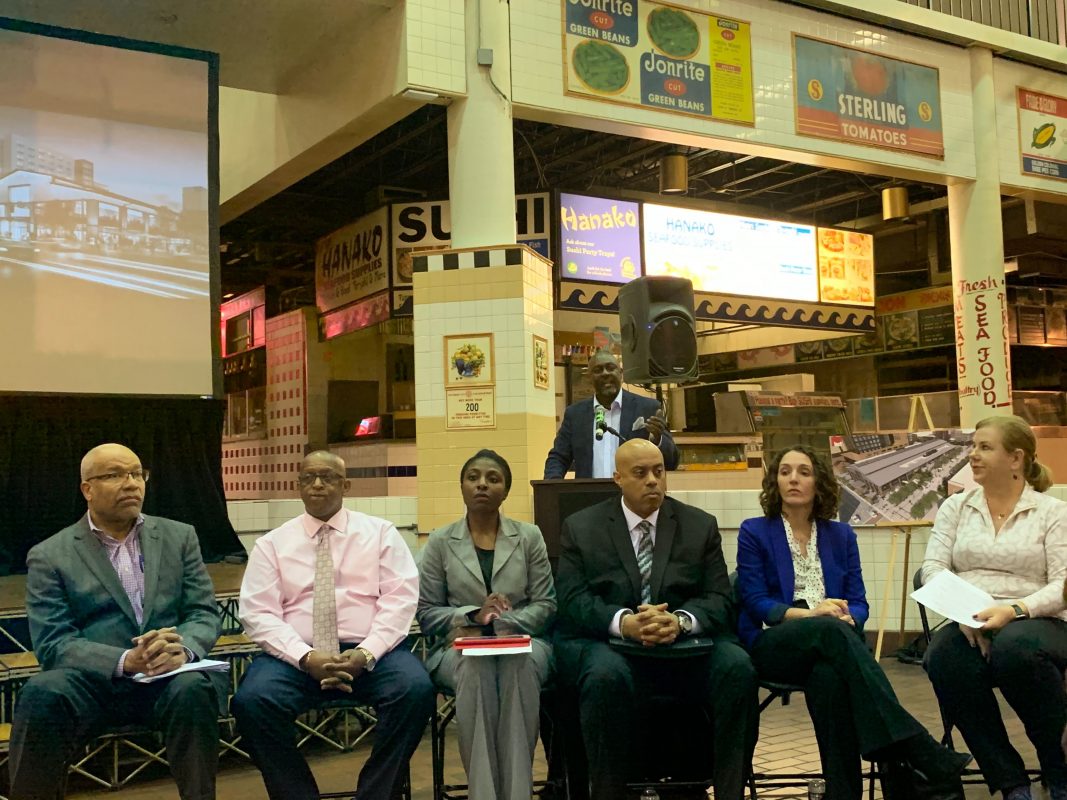
Throughout the recent discussions surrounding the redevelopment of Lexington Market, led by Baltimore-based development firm Seawall, preserving its integrity and ensuring the safety of the community have been at the forefront. The longest continually running market in the United States has remained open—and will remain open during construction—in the midst of considerations about its next chapter.
That journey will officially begin with a groundbreaking ceremony featuring remarks by Governor Larry Hogan and Mayor Bernard C. “Jack” Young on Tuesday, February 18.
At the most recent in a series of public meetings in the market’s arcade building last week, city leaders and developers gave a status update on the project to 150 attendees. A panel featuring members of law enforcement and government officials, including councilman Eric Costello and City Council President Brandon Scott, addressed streetscape safety, environmental concerns, and stakeholders’ plans to tackle these issues.
“There’s fear and hope in the community,” says Pickett Slater Harrington, head of Seawall’s community engagement team who served as the meeting’s moderator. “There is this fear of things changing. Lexington Market has been around for 230 years, and it’s personal to people and part of the fabric of Baltimore.”
The transformation of Lexington Market is a $40 million dollar project funded by New Market Tax Credits, bank loans, city grants, and a $2 million contribution from the market itself. Plans call for a new market building constructed on the current south parking lot, the demolition of the arcade building to pave the way for a pedestrian plaza on Lexington Street, and the salvaging of the East Market in a phase two redevelopment. The current structure will remain open during renovations and the full revamp is slated to be completed by 2021.
At last week’s meeting, attendees submitted comment cards with pressing questions such as how to combat potential crime, create sustainable change in safety measures, and curb drug dealing in the area. The common thread of city leaders’ answers to these questions was a need for collaboration.
“Lexington Market is a Baltimore asset,” Slater Harrington says. “To have city leadership sit here and say that they’re invested in Lexington Market is huge symbolically. That’s important in developing a vision for an institutional icon.”
City leaders were also asked to share their vision for the market. Baltimore Mayor Bernard C. “Jack” Young harkened back to memories of visiting the market in its “glory days” with his grandmother. Major Daryl Gaines, Commanding Officer of the Baltimore Police Department’s Central District, evoked Disney World in describing the type of attraction the market could become for locals and outside visitors.
Creating this type of environment is a multifaceted process, but it will perhaps be most defined by the vendors that inhabit the space.
“This is one of the most diverse communities in Baltimore City,” says Kristen Mitchell, executive director of Market Center Merchants Association, a nonprofit that promotes commerce and works to attract businesses in a 27-block area around Lexington Market. “We want to make sure that the vendors reflect that diversity.”
The vendor selection process will begin in March with two rounds of applications to fill the 60 permanent slots available. Seawall has said that it will place an emphasis on highlighting businesses run by women and those from African American and immigrant communities. Slater Harrington adds there will be three different types of vendors, including those who offer fresh food and produce, prepared food stalls, and specialty retail. Applications are open to anyone interested, and current vendors still in operation will have the opportunity to opt-in.
“Existing vendors love the market, and they’re ready for us to invest in them,” Slater Harrington says. “They’ve been with the market in its ups and downs—everything that we’re creating for the new market, we’re creating as a support system for those existing businesses so they can transition and move into the market.”
From the merchants’ perspective, Robert Thomas, executive director for Baltimore Public Markets, says that vendors are most concerned about the timeline moving forward and whether or not they will be accepted into the new building once it’s complete.
“Change is not something that people look forward to,” Thomas says. “[Some merchants] have routines that they’ve been in for 15 or 20 or 30 years, and it’s worked for them. This is a different animal now. We’re really trying to manage the transition so that people land on their feet or at least know in which direction they’re headed.”
Thomas also says that the renovation and subsequent opening of the new market could be a natural marker for longtime vendors to step aside. “There is a natural attrition we expect to take place,” he says.
As for the immediate future, following the groundbreaking ceremony next week will be the next quarterly meeting centered around community programming and preserving the market’s history in three months.
“Baltimore as a city is at a decision point,” Slater Harrington says. “We’re deciding what type of city we’re going to be. Are we going to be a city with opportunity and access to some, or a city with opportunity and access for all? We’re thinking about that every day in every decision that we make with Lexington Market.”